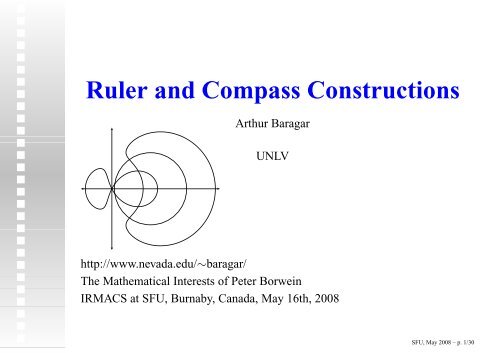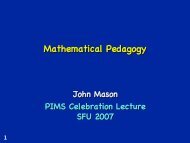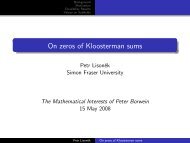Ruler and Compass Constructions
Ruler and Compass Constructions
Ruler and Compass Constructions
- No tags were found...
You also want an ePaper? Increase the reach of your titles
YUMPU automatically turns print PDFs into web optimized ePapers that Google loves.
<strong>Ruler</strong> <strong>and</strong> <strong>Compass</strong> <strong>Constructions</strong><br />
Arthur Baragar<br />
UNLV<br />
http://www.nevada.edu/∼baragar/<br />
The Mathematical Interests of Peter Borwein<br />
IRMACS at SFU, Burnaby, Canada, May 16th, 2008<br />
SFU, May 2008 – p. 1/30
No fractals appear in this talk<br />
SFU, May 2008 – p. 2/30
It is impossible to trisect an arbitrary angle<br />
SFU, May 2008 – p. 3/30
It is impossible to trisect an arbitrary angle using a<br />
straightedge <strong>and</strong> compass.<br />
SFU, May 2008 – p. 4/30
It is impossible to trisect an arbitrary angle using a<br />
straightedge <strong>and</strong> compass.<br />
But it is possible to trisect an arbitrary angle using a<br />
ruler <strong>and</strong> compass. This was known to Archimedes.<br />
SFU, May 2008 – p. 5/30
It is impossible to trisect an arbitrary angle using a<br />
straightedge <strong>and</strong> compass.<br />
But it is possible to trisect an arbitrary angle using a<br />
ruler <strong>and</strong> compass. This was known to Archimedes.<br />
The ancient Greeks investigated a number of<br />
variations on the classical tools.<br />
SFU, May 2008 – p. 6/30
It is impossible to trisect an arbitrary angle using a<br />
straightedge <strong>and</strong> compass.<br />
But it is possible to trisect an arbitrary angle using a<br />
ruler <strong>and</strong> compass. This was known to Archimedes.<br />
The ancient Greeks investigated a number of<br />
variations on the classical tools.<br />
• Solid constructions<br />
• <strong>Ruler</strong> <strong>and</strong> compass constructions<br />
SFU, May 2008 – p. 7/30
Solid constructions<br />
The tools include a conic drawing tool.<br />
Using the curve y = x 2 <strong>and</strong> the circle centered at<br />
(a,b) that goes through (0, 0),<br />
(x − a) 2 + (x 2 − b) 2 = a 2 + b 2<br />
x 4 + (1 − 2b)x 2 y=x<br />
− 2ax = 0<br />
2<br />
(a,b)<br />
0 1<br />
SFU, May 2008 – p. 8/30
Solid constructions<br />
The tools include a conic drawing tool.<br />
Using the curve y = x 2 <strong>and</strong> the circle centered at<br />
(a,b) that goes through (0, 0),<br />
(x − a) 2 + (x 2 − b) 2 = a 2 + b 2<br />
x 3 y=x<br />
+ (1 − 2b)x − 2a = 0<br />
2<br />
(a,b)<br />
0 1<br />
SFU, May 2008 – p. 9/30
Solid constructions<br />
x 3 + (1 − 2b)x − 2a = 0<br />
• We can extract cube roots 3 √ α:<br />
Set (a,b) = (α/2, 1/2).<br />
SFU, May 2008 – p. 10/30
Solid constructions<br />
x 3 + (1 − 2b)x − 2a = 0<br />
• We can extract cube roots 3 √ α:<br />
Set (a,b) = (α/2, 1/2).<br />
• We can trisect the angle θ:<br />
Identity: cos 3α = 4 cos 3 α − 3 cos α<br />
So solve: 4x 3 − 3x − cosθ = 0.<br />
SFU, May 2008 – p. 11/30
Solid constructions<br />
x 3 + (1 − 2b)x − 2a = 0<br />
• We can extract cube roots 3 √ α:<br />
Set (a,b) = (α/2, 1/2).<br />
• We can trisect the angle θ:<br />
Identity: cos 3α = 4 cos 3 α − 3 cos α<br />
So solve: 4x 3 − 3x − cosθ = 0.<br />
• We can construct anything in a 2-3-tower.<br />
• The points of intersection of two conics lie in a<br />
2-3-tower.<br />
SFU, May 2008 – p. 12/30
The regular 7-gon<br />
• Set ω = e 2πi/7<br />
• ω 7 − 1 = 0<br />
• Set x = ω + ω −1 = 2 cos(2π/7)<br />
• x 3 + x 2 − 2x − 1 = 0<br />
• Complete the cube: Set x = u − 1/3<br />
• u 3 − 7 3 u − 7 27 = 0 SFU, May 2008 – p. 13/30
The regular 7-gon<br />
• u 3 − 7 3 u − 7 27 = 0<br />
• x 3 + (1 − 2b)x − 2a = 0<br />
• So set (a,b) = ( 7<br />
54 , )<br />
5<br />
3<br />
SFU, May 2008 – p. 14/30
The regular 7-gon<br />
(— 5<br />
74 ,5)<br />
—<br />
3<br />
y=x 2 SFU, May 2008 – p. 15/30<br />
0 1
The regular 7-gon<br />
(— 5<br />
74 ,5)<br />
—<br />
3<br />
y=x 2 SFU, May 2008 – p. 16/30<br />
0 1 u + 1 3 –
The regular 7-gon<br />
( 5<br />
7<br />
— —<br />
4 ,5) 3<br />
u<br />
0 – 2<br />
1 u + 1–<br />
3<br />
y=x 2 SFU, May 2008 – p. 17/30
The regular 7-gon<br />
( 5<br />
7<br />
— —<br />
4 ,5) 3<br />
u<br />
0 – 2<br />
1 u + 1–<br />
3<br />
y=x 2 SFU, May 2008 – p. 18/30
The regular 7-gon<br />
( 5<br />
7<br />
— —<br />
4 ,5) 3<br />
u<br />
0 – 2<br />
1 u + 1–<br />
3<br />
y=x 2 SFU, May 2008 – p. 19/30
<strong>Ruler</strong> <strong>and</strong> compass<br />
constructions<br />
Our ruler will have two markings on it, a unit distance<br />
apart.<br />
In constructions involving rulers, we are allowed to<br />
place a marking on one constructed object (line or<br />
circle), <strong>and</strong> the other marking on another constructed<br />
object. We are then allowed to move the ruler,<br />
keeping the markings on the objects, until the ruler<br />
passes through some already constructed point.<br />
SFU, May 2008 – p. 20/30
Archimedes’ trisection<br />
2α<br />
α<br />
2α<br />
α<br />
3α<br />
SFU, May 2008 – p. 21/30
Curve interpretation<br />
The conchoid of Nicomedes<br />
SFU, May 2008 – p. 22/30
Curve interpretation<br />
The Limaçon<br />
SFU, May 2008 – p. 23/30
The conchoid<br />
The line has polar equation<br />
r cos θ = a, so<br />
r = a secθ ± 1<br />
r cos θ − a = ± cosθ<br />
r(x − a) = ±x<br />
(x 2 + y 2 )(x − a) 2 = x 2 SFU, May 2008 – p. 24/30
The generalized limaçon<br />
Algebraic of degree 6.<br />
SFU, May 2008 – p. 25/30
Intersections<br />
Intersecting<br />
• the conchoid with a line gives 4 points.<br />
• the conchoid with a circle gives 8 points, but 2<br />
are at infinity <strong>and</strong> factor out.<br />
• the generalized limaçon with a line gives 6 points.<br />
• the generalized limaçon with a circle gives 12<br />
points, but 6 are at infinity <strong>and</strong> factor out.<br />
SFU, May 2008 – p. 26/30
The possibilities<br />
• One can extract cube roots of lengths<br />
(Nicomedes).<br />
• All points in a 2-3-tower over Q are constructible.<br />
• All constructible points lie in a 2-3-5-6-tower<br />
over Q.<br />
SFU, May 2008 – p. 27/30
A provocative example<br />
Let us intersect the conchoid<br />
with a = 2 with the circle<br />
centered at (1, 1) <strong>and</strong><br />
through the point (0, 2).<br />
SFU, May 2008 – p. 28/30
A provocative example<br />
Solving, we get<br />
x 6 − 7x 5 + 14x 4 − 2x 3 − 10x 2 − 12x + 18 = 0.<br />
Factoring out x − 3, we get<br />
x 5 − 4x 4 + 2x 3 + 4x 2 + 2x − 6 = 0.<br />
By Eisenstein’s criterion, this is irreducible. The<br />
polynomial has two complex roots, so the Galois<br />
group includes a 2-cycle. Hence, it is all of S 5 . Thus<br />
we can solve for x using a ruler <strong>and</strong> compass, but<br />
cannot solve it using extractions of roots.<br />
SFU, May 2008 – p. 29/30
Happy Birthday Peter<br />
SFU, May 2008 – p. 30/30






